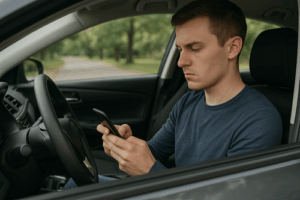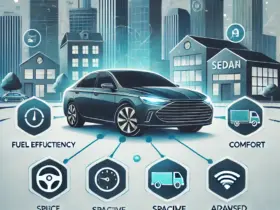
Texting while driving feels like a quick, harmless act, but its consequences can be devastating. A momentary glance at a phone diverts attention from the road, risking lives and property. Despite widespread awareness, many drivers underestimate the dangers. This guide uncovers the hidden risks of texting while driving, highlighting why it’s a habit to break.
Cognitive Distraction and Reaction Time
Texting demands mental focus, pulling attention from driving. Reading or typing a message engages the brain, reducing awareness of road conditions. Studies show texting drivers take up to two seconds longer to react. That delay, at 60 mph, means traveling over 170 feet blindly. As one of the main dangers of texting while driving, cognitive distraction is a silent threat, impairing judgment without obvious signs.
Visual and Manual Impairment
Texting takes eyes off the road and hands off the wheel. Even a five-second glance equals driving a football field’s length blind at 55 mph. Holding a phone reduces steering control, increasing swerving risks. These combined impairments—visual and manual—make texting one of the most dangerous driving distractions, far beyond adjusting the radio or eating.
Increased Crash Risk
The statistics are stark. Texting while driving raises crash likelihood by up to 23 times, per the National Highway Traffic Safety Administration. In 2022, distracted driving caused over 3,000 deaths in the U.S., with texting as a leading factor. Young drivers, often glued to phones, face higher risks. These numbers reveal texting’s deadly potential, often underestimated by habitual offenders.
Legal and Financial Consequences
Texting while driving is illegal in most states, with penalties including:
- Fines ranging from $50 to $500
- License points or suspension
- Increased insurance premiumsBeyond legal costs, crashes lead to repair bills, medical expenses, or lawsuits. A single texting-related accident can bring financial strain, compounding the emotional toll of injury or loss. Legal repercussions serve as a reminder to prioritize safety.
Impact on Others
Texting endangers not just the driver but everyone nearby. Pedestrians, cyclists, and other motorists face heightened risks. A texting driver may miss a stop sign and hit a child crossing the street. Families suffer when preventable accidents claim lives. The ripple effect of one distracted moment can shatter communities, making texting a selfish act with far-reaching harm.
Technology’s Role in Distraction
Smartphones, while convenient, fuel texting’s allure. Notifications tempt drivers to check messages, even briefly. Social media and instant messaging apps create pressure to respond instantly. This constant connectivity normalizes risky behavior, masking its dangers. Recognizing technology’s role helps drivers resist the urge to engage while behind the wheel.
Breaking the Habit
Overcoming texting while driving requires commitment. Turn off notifications or use “Do Not Disturb” modes. Place phones out of reach, like in the glovebox. Apps like LifeSaver block texts while driving, reinforcing focus. Passengers can manage messages, freeing the driver to concentrate. Small changes build safer habits, reducing temptation.
The hidden dangers of texting while driving—cognitive, visual, and manual distractions—make it a lethal choice. Its risks, from crashes to legal penalties, affect drivers and communities alike. Technology fuels the problem, but awareness and discipline can counter it. By silencing phones and prioritizing the road, drivers protect lives and prevent tragedy. Breaking this habit isn’t just a personal choice; it’s a responsibility to everyone sharing the road. Choose safety, and put the phone down.




